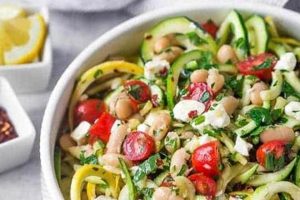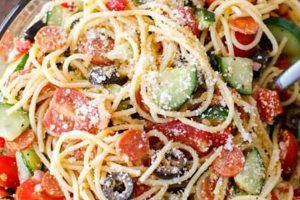A vibrant and flavorful dish, typically composed of fresh ingredients like crisp lettuce, beans, corn, tomatoes, avocado, and grilled chicken or fish. Often, tortilla strips or other crunchy elements add texture, while a zesty cilantro-lime dressing or a creamy avocado ranch provides a distinctive southwestern flair. Variations may include ingredients like bell peppers, red onion, jalapenos, and queso fresco, offering a diverse range of flavor profiles.
This type of salad provides a nutritious and satisfying meal option, offering a balance of protein, healthy fats, and complex carbohydrates. The abundance of fresh vegetables contributes essential vitamins and minerals. Its adaptability to diverse palates and dietary needs makes it a popular choice for both casual and more formal dining occasions. Originating from the culinary traditions of the American Southwest, it reflects the region’s rich agricultural heritage and its blending of indigenous, Spanish, and Mexican influences.
The following sections will explore various aspects of creating this culinary delight, from selecting the freshest ingredients to mastering the art of the perfect dressing and exploring innovative variations on the classic theme.
Tips for Creating the Perfect Southwestern Salad
Crafting a truly exceptional salad involves careful consideration of ingredients, flavors, and textures. These tips offer guidance for achieving optimal results.
Tip 1: Embrace Fresh, High-Quality Ingredients: The foundation of any successful salad lies in the quality of its components. Opt for ripe, seasonal produce for the most vibrant flavors and textures. Locally sourced ingredients, when available, offer superior freshness.
Tip 2: Balance Flavors and Textures: Consider the interplay of sweet, savory, spicy, and tangy elements. Combine creamy avocados with crisp lettuce, crunchy tortilla strips with juicy tomatoes, and spicy jalapeos with cooling cilantro.
Tip 3: Master the Art of the Dressing: A well-crafted dressing elevates a salad from simple to extraordinary. Whether a classic cilantro-lime vinaigrette or a creamy avocado ranch, ensure the dressing complements the other ingredients without overpowering them.
Tip 4: Grill for Added Depth: Grilling proteins like chicken, fish, or tofu adds a smoky char and enhances their inherent flavors, adding another dimension to the salad.
Tip 5: Don’t Overcrowd the Plate: Allow each ingredient to shine by avoiding overcrowding. A balanced presentation enhances both the visual appeal and the enjoyment of the dish.
Tip 6: Seasoning is Key: Proper seasoning enhances the natural flavors of the ingredients. A touch of salt, pepper, and perhaps a pinch of cumin can make a noticeable difference.
Tip 7: Customize to Preference: Adaptability is one of this salad’s greatest strengths. Feel free to experiment with different ingredients and dressings to create a personalized version.
By following these guidelines, one can achieve a harmonious blend of flavors and textures, resulting in a truly satisfying culinary experience.
The provided insights should assist in creating a delicious and well-balanced salad that caters to individual preferences and dietary needs. Experimentation and adaptation are encouraged to fully explore the versatility of this dish.
1. Fresh Ingredients
The emphasis on fresh ingredients is paramount in a southwestern salad recipe. The vibrancy and overall quality of the dish directly correlate to the freshness of its components. Utilizing peak-season produce not only maximizes flavor but also contributes to a more satisfying textural experience.
- Locally Sourced Produce
Whenever possible, incorporating locally sourced produce elevates the salad’s flavor profile. Farmers’ markets offer a wide array of seasonal vegetables and herbs, ensuring optimal ripeness and minimizing transit time from farm to table. This practice supports local agriculture and reduces environmental impact.
- Ripe Avocados
Avocados contribute a creamy texture and healthy fats. Selecting perfectly ripe avocados, yielding gently to pressure, ensures optimal flavor and a smooth, buttery consistency. Their delicate nature necessitates careful handling to avoid bruising.
- Vibrant Tomatoes
Tomatoes provide juiciness and a burst of acidity. Choosing ripe, in-season tomatoes, whether heirloom varieties or classic beefsteak, enhances both the visual appeal and the flavor complexity of the salad.
- Crisp Lettuce
The foundation of any salad lies in the quality of its greens. Crisp romaine, butter lettuce, or a blend of spring greens offer a refreshing counterpoint to the richer ingredients. Proper storage and handling maintain their texture and prevent wilting.
The careful selection and incorporation of these fresh ingredients contribute significantly to the overall success of a southwestern salad. Their combined flavors and textures create a harmonious and refreshing culinary experience, showcasing the essence of southwestern cuisine. The quality of these components ultimately determines the dish’s overall appeal and nutritional value.
2. Flavorful Dressing
Flavorful dressing forms an integral component of a successful southwestern salad recipe. It provides a cohesive element, uniting diverse ingredients while adding depth and complexity. The dressing’s role extends beyond simply adding moisture; it enhances inherent flavors and introduces a characteristic tang that balances the richness of other components. A thoughtfully crafted dressing elevates the salad from a collection of individual ingredients to a harmonious culinary creation. For instance, a classic cilantro-lime vinaigrette contributes brightness and acidity, cutting through the richness of avocado and cheese while complementing the sweetness of corn and tomatoes. Alternatively, a creamy avocado ranch dressing provides a cooling counterpoint to the heat of jalapeos, adding a layer of richness that complements grilled chicken or fish.
The interplay between the dressing and other salad components is crucial. The dressing should complement, not overpower, the flavors of the fresh produce and proteins. A delicate balance ensures that each ingredient retains its distinct character while contributing to the overall flavor profile. Consider the intensity of the dressing’s flavors when selecting ingredients; a robust chipotle-lime dressing may pair well with grilled steak and robust vegetables, while a lighter vinaigrette might better suit delicate greens and grilled shrimp. Practical applications include adjusting the dressing’s consistency to suit personal preference; a thinner vinaigrette offers a lighter touch, while a thicker dressing clings more readily to the salad components.
Ultimately, the choice of dressing significantly impacts the overall sensory experience of a southwestern salad. It represents an opportunity to enhance the dish’s complexity and create a cohesive flavor profile. Careful consideration of flavor pairings and textural interactions ensures a well-balanced and satisfying result, reflecting the essence of southwestern cuisine. Challenges may arise in achieving the desired balance, requiring adjustments to ingredient ratios or the addition of complementary spices and herbs. This understanding of the dressing’s role enables informed decisions regarding flavor profiles and contributes to a more refined and enjoyable culinary experience.
3. Textural Variety
Textural variety constitutes a defining characteristic of a successful southwestern salad. The interplay of contrasting textures elevates the sensory experience, transforming a simple combination of ingredients into a dynamic and engaging culinary creation. A well-composed salad incorporates elements that offer crispness, creaminess, crunch, and chewiness, ensuring a stimulating and satisfying experience with each bite. This textural diversity plays a crucial role in enhancing the overall enjoyment and perceived complexity of the dish.
Consider the contrast between crisp romaine lettuce and creamy avocado slices, further amplified by the addition of crunchy tortilla strips or toasted pepitas. These contrasting textures create a multi-dimensional experience that stimulates the palate and enhances the perception of individual flavors. The crispness of the lettuce provides a refreshing counterpoint to the richness of the avocado, while the crunchy elements introduce an element of surprise and delight. Grilled or blackened chicken or fish introduces a firmer, chewier texture, further diversifying the sensory experience. Even the addition of black beans or corn contributes a subtle textural variation, adding another layer of interest to each bite.
Understanding the importance of textural variety allows for informed choices when composing a southwestern salad. Achieving this balance necessitates a thoughtful selection of ingredients, considering not only their flavor profiles but also their textural contributions. Challenges may arise in maintaining this balance, particularly when incorporating ingredients with varying moisture contents. Practical applications include toasting nuts and seeds to enhance their crunch or allowing grilled proteins to rest before slicing, ensuring optimal texture. Ultimately, mastery of textural interplay elevates the southwestern salad from a simple dish to a complex and rewarding culinary experience, reflecting a nuanced understanding of flavor and texture interactions.
4. Protein Choices
Protein selection significantly influences the nutritional value and overall character of a southwestern salad. Appropriate choices complement the existing flavors and textures while contributing essential nutrients. The following facets explore common protein options and their respective impacts on the final dish.
- Grilled Chicken or Fish
Grilled chicken or fish provides lean protein and complements the fresh flavors of the salad. Grilling imparts a smoky char that enhances the overall complexity of the dish. Chicken breast or fish fillets, marinated in citrus and spices, offer a healthy and flavorful option. The choice between chicken and fish allows for customization based on dietary preferences and desired flavor profiles. Grilled chicken provides a versatile base, while grilled fish, such as mahi-mahi or tilapia, offers a lighter, flakier texture.
- Black Beans or other legumes
Black beans, pinto beans, or other legumes offer a plant-based protein source and contribute a hearty texture. Their earthy flavors complement the southwestern spices commonly used in the salad dressing. Beans also provide dietary fiber, enhancing the nutritional value of the meal. Different bean varieties introduce subtle flavor variations; black beans offer a robust, earthy taste, while pinto beans provide a milder, slightly sweet flavor.
- Tofu or Tempeh
Tofu or tempeh offers another plant-based protein alternative. These soy-based products absorb flavors readily, making them ideal for marinating in southwestern-inspired spices. Their firm texture provides a satisfying chewiness that contrasts with the fresh vegetables. Tofu offers a neutral flavor profile, while tempeh possesses a nuttier, more pronounced taste.
- Ground Meat (Beef or Turkey)
Seasoned ground meat, such as beef or turkey, can be incorporated, offering a richer, more savory dimension. This option caters to those seeking a heartier protein source. The meat can be cooked with onions, peppers, and southwestern spices to enhance its flavor profile. Lean ground turkey provides a healthier alternative to beef, while still delivering a robust flavor.
The chosen protein significantly impacts the overall composition and nutritional balance of the southwestern salad. Considerations include dietary restrictions, flavor preferences, and desired textural elements. Selecting the appropriate protein ensures a well-rounded and satisfying meal that aligns with individual needs and culinary objectives. Further exploration of protein options and their respective culinary applications allows for greater customization and the creation of unique flavor profiles.
5. Spice Level
Spice level represents a crucial element in defining the character of a southwestern salad. Its judicious application contributes depth and complexity, enhancing the interplay of other flavors. Understanding the role of spice and its careful integration into the salad allows for a tailored sensory experience, ranging from mildly piquant to robustly fiery. This exploration examines various facets of spice level within the context of southwestern cuisine.
- Jalapeos: Fresh vs. Pickled
Jalapeos provide a readily available source of heat. Fresh jalapeos offer a bright, vegetal flavor alongside their spiciness, while pickled jalapeos contribute a tangy acidity. The choice between fresh and pickled depends on the desired flavor profile and the balance of other ingredients. Incorporating jalapeos requires careful consideration of their heat level, which can vary significantly. Removing the seeds and membranes reduces the spiciness, while leaving them intact intensifies the heat. Practical application involves finely dicing jalapeos for even distribution of heat throughout the salad.
- Chili Powder and other Ground Spices
Chili powder blends offer a complex depth of flavor beyond simple heat. Ancho chili powder contributes a rich, fruity sweetness, while chipotle powder introduces a smoky heat. Other ground spices, such as cumin, coriander, and oregano, enhance the overall complexity of the salad’s flavor profile. The careful balance of these spices allows for a nuanced flavor experience, avoiding an overwhelming heat that might mask the freshness of other ingredients. Experimentation with different chili powder blends and spice combinations allows for customization and the creation of unique flavor profiles.
- Hot Sauces: Flavorful Heat
Hot sauces offer a convenient way to add both heat and flavor. Variations range from vinegar-based sauces with a sharp tang to those with a smoky or fruity character. The chosen hot sauce should complement the other ingredients and the overall flavor profile of the salad. Adding hot sauce allows for individual adjustment of spice level, catering to varying preferences. Practical application involves offering a variety of hot sauces alongside the salad, allowing diners to customize their spice experience.
- Moderation and Balance
Moderation and balance are key to successfully integrating spice into a southwestern salad. The goal is to enhance, not overpower, the other flavors present. The spice level should complement the freshness of the vegetables, the richness of the dressing, and the chosen protein. Overly spicy salads can mask the delicate flavors of other ingredients, diminishing the overall enjoyment of the dish. Careful tasting and adjustment throughout the preparation process ensure a harmonious balance of flavors.
The considered application of spice is essential in crafting a truly exceptional southwestern salad. It contributes depth, complexity, and a tailored sensory experience. The interplay of different spice sources, coupled with an understanding of their individual characteristics, allows for a nuanced and balanced flavor profile, enhancing the overall enjoyment of this vibrant culinary creation. The spice level chosen should reflect personal preference while remaining harmonious with the other components of the salad. A balanced approach to spice integration distinguishes a well-crafted southwestern salad from a merely adequate one.
Frequently Asked Questions
This section addresses common inquiries regarding southwestern salad recipes, providing concise and informative responses.
Question 1: What constitutes an authentic southwestern salad?
Authenticity derives from the use of fresh, regional ingredients and characteristic flavor profiles. While variations exist, core elements typically include ingredients like corn, beans, tomatoes, avocado, and a cilantro-lime dressing. Grilled chicken or fish is often incorporated, reflecting the culinary traditions of the American Southwest.
Question 2: Can the spice level be adjusted?
Spice level is readily adaptable. Jalapeos, chili powder, or hot sauce can be added or omitted based on individual preference. Removing seeds and membranes from jalapeos mitigates their heat, while incorporating milder chili powders like ancho offers flavor complexity without excessive spiciness.
Question 3: What are suitable protein alternatives for vegetarian or vegan diets?
Black beans, pinto beans, or other legumes offer excellent plant-based protein sources. Tofu or tempeh, marinated in southwestern spices, provide additional vegetarian/vegan options. These alternatives contribute essential nutrients and complement the salad’s flavor profile.
Question 4: How can the salad be made more substantial for a main course?
Adding grilled chicken, fish, or a heartier protein like steak transforms the salad into a more substantial meal. Quinoa or brown rice can also be incorporated for added complex carbohydrates. Increasing the quantity of beans or legumes provides additional fiber and protein.
Question 5: What are suitable dressing alternatives to cilantro-lime vinaigrette?
Creamy avocado ranch dressing offers a flavorful alternative, complementing the richness of other ingredients. A chipotle-lime vinaigrette adds a smoky dimension. Variations incorporating buttermilk or different herbs and spices can further diversify flavor profiles.
Question 6: How can the salad’s textural variety be enhanced?
Toasted pepitas, sunflower seeds, or crushed tortilla chips add satisfying crunch. Roasted corn or other grilled vegetables offer textural contrast. Incorporating different types of lettuce, such as romaine and butter lettuce, adds further dimension.
Addressing these common queries offers clarity regarding key aspects of southwestern salad preparation. The provided information facilitates informed choices, allowing for customization and a more satisfying culinary experience.
The following section will delve into specific recipe variations and offer step-by-step instructions for creating diverse and flavorful southwestern salads.
Conclusion
Exploration of this culinary theme reveals a dish adaptable to a wide range of preferences and dietary needs. Emphasis on fresh, high-quality ingredients, balanced flavor profiles, and textural variety contributes to a satisfying and nutritious meal. Understanding the interplay of core componentsfrom crisp greens and vibrant vegetables to flavorful proteins and zesty dressingsallows for informed choices and creative variations. Spice level customization, protein selection, and dressing options offer further avenues for personalization.
The inherent versatility of a southwestern salad provides a canvas for culinary expression. Continued exploration of regional ingredients and flavor combinations promises further evolution of this vibrant dish. Its adaptability ensures relevance within a dynamic culinary landscape, offering a refreshing and flavorful experience for both novice and experienced cooks alike.






